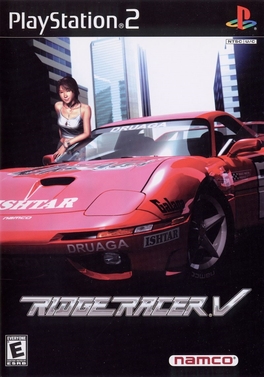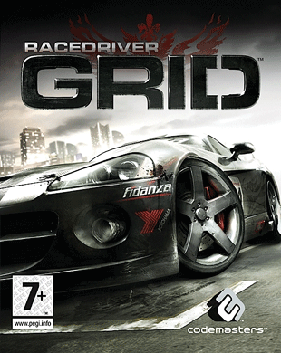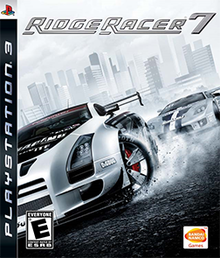
Pole Position is an arcade racing simulation video game released by Namco in 1982 and licensed to Atari, Inc. for US manufacture and distribution, running on the Namco Pole Position arcade system board. It is considered one of the most important titles from the golden age of arcade video games. Pole Position was an evolution of Namco's earlier arcade racing electro-mechanical games, notably F-1 (1976), whose designer Sho Osugi worked on the development of Pole Position.

Tekken is a Japanese media franchise centered on a series of fighting video and arcade games developed and published by Bandai Namco Entertainment. The franchise also includes film and print adaptations.
Ridge Racer is a racing video game series developed and published for arcade systems and home game consoles by Bandai Namco Entertainment, formerly Namco. The first game, Ridge Racer (1993), was originally released in arcades for the Namco System 22 hardware, later ported to the PlayStation two years later as a launch title. It was met with several sequels and spin-off games for multiple platforms, the latest being the mobile game Ridge Racer Draw & Drift (2016) with the latest mainline game being Ridge Racer 7 (2006). Gameplay involves the player racing against computer-controlled opponents to be the first to finish in a race. Drifting is a core aspect of the series, and is used to keep speed while turning corners.

Mr. Driller is a puzzle video game franchise created by Yasuhito Nagaoka and Hideo Yoshizawa for Namco. The eponymous first game was released in 1999 for arcades and several home consoles, such as the PlayStation. Gameplay in the series consists of controlling Susumu Hori, the titular Mr. Driller, or one of his friends and destroying colorful formations of blocks to make it to the bottom of a well. In order to survive, players need to collect air capsules to replenish their depleting oxygen and avoid being crushed by falling blocks.

Midnight Club 3: Dub Edition is a 2005 racing video game developed by Rockstar San Diego and published by Rockstar Games. It is the third installment in the Midnight Club series. Like previous installments in the series, the game is an arcade-style racer and focuses on wild, high-speed racing, rather than realistic physics and driving. The name is derived from a partnership between Rockstar and DUB Magazine, which features heavily in the game in the form of DUB-sponsored races and DUB-customized vehicles as prizes.
Mario Kart Arcade GP is an arcade sub-series of Nintendo's Mario Kart series, developed and published by Namco and later Bandai Namco Games under license from Nintendo. In all installments, for an additional fee, a player's data can be saved on a magnetic card which can be inserted into the machine again later to retain unlocked items and records. Nintendo had a limited role in development, mainly for quality control purposes. It has a camera to photograph the player's face. The photo can be customized and displayed above the player's character during multiplayer races.

Ridge Racer Revolution is a racing video game developed and published by Namco for the PlayStation in 1995. It is the sequel to the PlayStation version of Ridge Racer. Like the original Ridge Racer, the player races computer-controlled cars with the objective of winning a series of races, and supports Namco's NeGcon controller. Ridge Racer Revolution adds two hidden cars, and two-player support via the PlayStation Link cable, and took roughly the same time to develop as the first. The intention was to increase the depth and add features.

R4: Ridge Racer Type 4 is a racing video game developed and published by Namco for the PlayStation. It is the fourth title in the Ridge Racer series after Rage Racer and the last to be released for the PlayStation. It was released on December 3, 1998 in Japan and further released the following year in Europe and North America. It was later re-released on the PlayStation Network in 2011, again in 2023 for PlayStation 4 and PlayStation 5, and pre-loaded on the PlayStation Classic which was released on December 3, 2018. It is the first Ridge Racer series game on the PlayStation to use Gouraud shading on polygons and was followed by Ridge Racer V in 2000.

Ridge Racer V is a 2000 racing game developed and published by Namco for the PlayStation 2, as a launch game for that platform. It is the fifth title of the Ridge Racer series succeeding Ridge Racer Type 4 and was followed by Ridge Racer 6 in 2005. The game received a home-to-arcade port named Ridge Racer V: Arcade Battle.

Ridge Racer 6 is a racing game by Namco released in 2005. It was the sixth console game in the Ridge Racer series but unlike the previous mainline entries, which were released for PlayStation consoles, this entry was released exclusively as a launch title for the Xbox 360. In a similar fashion to the first Ridge Racer on PS1, Ridge Racer V on PlayStation 2, Ridge Racer(s) on PlayStation Portable and eventually Ridge Racer 7 on PlayStation 3. All are exclusive launch titles for their respective consoles.

Digimon Racing is a racing video game developed by Griptonite Games and published by Bandai for the Game Boy Advance. Part of the Digimon media franchise and video game series, it utilizes Digimon's characters and elements. Its gameplay largely resembles that of traditional racing games, but also utilizes elements of kart racing and action games. Its eleven playable characters can be increased to over 40 via Digivolution.

Ridge Racer, released in Japan as Ridge Racers, is an arcade racing video game developed by Namco for the PlayStation Portable. It is named after the eponymous Ridge Racer video game series to which it belongs. The game was released in Japan on 12 December 2004, in North America on 24 March 2005, and in Europe and Australia on 1 September as a launch title. Available in the game is a fully playable version of the Namco arcade game New Rally-X.

Ridge Racer is a 1993 racing video game developed and published by Namco. It was released initially on the Namco System 22 arcade system board and ported to the PlayStation console in 1994. It is the first title in the Ridge Racer series released for arcades and home consoles.

Ridge Racer 2, released in Japan as Ridge Racers 2, is an arcade-style racing game developed by Namco Bandai Games for the PlayStation Portable hand-held console, marking the 14th release in the Ridge Racer series and also the sequel to the PSP launch title Ridge Racer. It saw release in Japan on 14 September 2006, followed by its 13 October European launch and 19 October release in Australia. The original North American release was cancelled. On 20 December 2022, Ridge Racer 2 was made available worldwide to download on PlayStation 4 and PlayStation 5 as part of the PlayStation Plus Premium subscription service.

Race Driver: Grid is a 2008 racing video game developed and published by Codemasters for Microsoft Windows, PlayStation 3, Xbox 360, Nintendo DS, arcade, Java ME and OS X. It is the first game in the Grid series.

Naruto: Ultimate Ninja Storm, known in Japan as Naruto: Narutimate Storm is the first installment of the Ultimate Ninja Storm series, it is a fighting game developed by CyberConnect2 and published by Namco Bandai Games. The game was released for the PlayStation 3 (PS3) across North America, Europe and Australia in November 2008 and in Japan on January 15, 2009. It is based on the popular manga and anime series Naruto by Masashi Kishimoto, and the first installment of the Naruto: Ultimate Ninja series on the PS3.

Ridge Racer 3D is a racing video game for the Nintendo 3DS console published and developed by Namco Bandai Games. The game was released in Japan on 26 February 2011 and in North America on 22 March, five days prior to the launch of the Nintendo 3DS itself in that region. Ridge Racer 3D was also released in Europe on 25 March and in Australia on 31 March.

Ridge Racer Unbounded is a racing video game developed by Bugbear Entertainment and published by Namco Bandai Games for Microsoft Windows, PlayStation 3 and Xbox 360 in 2012. It is the eighth installment of the Ridge Racer franchise, and the first game in the series to be released on Windows. Unbounded is also the most recent game in the series to be released on home consoles as its successors only focused on handheld devices.

Ridge Racer, originally named Ridge Racer Vita, is a racing video game released for the PlayStation Vita as a launch title on 17 December 2011 in Japan, 22 February 2012 in Europe, 23 February in Australia and 13 March in North America. It is the 5th handheld game in the Ridge Racer series.

MotoGP 14 is a video game developed by Milestone.


















